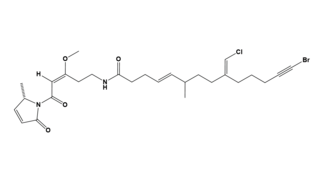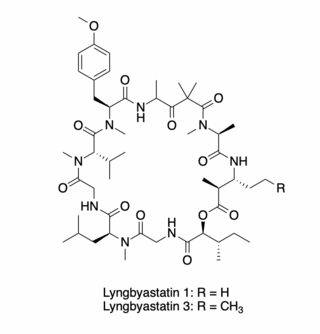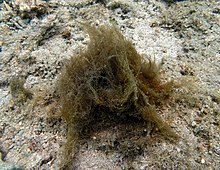
Cyanobacteria, also called Cyanobacteriota or Cyanophyta, are a phylum of gram-negative bacteria that obtain energy via photosynthesis. The name cyanobacteria refers to their color, which similarly forms the basis of cyanobacteria's common name, blue-green algae, although they are not usually scientifically classified as algae. They appear to have originated in a freshwater or terrestrial environment. Sericytochromatia, the proposed name of the paraphyletic and most basal group, is the ancestor of both the non-photosynthetic group Melainabacteria and the photosynthetic cyanobacteria, also called Oxyphotobacteria.

Lyngbya is a genus of cyanobacteria, unicellular autotrophs that form the basis of the oceanic food chain.

Oscillatoria is a genus of filamentous cyanobacterium which is often found in freshwater environments, such as hot springs, and appears blue-green. Its name refers to the oscillating motion of its filaments as they slide against each other to position the colony facing a light source. Oscillatoria reproduces by fragmentation, facilitated by dead cells which separate a filament into separate sections, or hormogonia, which then grow. Oscillatoria uses photosynthesis to survive and reproduce. Each filament of oscillatoria consists of trichome which is made up of rows of cells. The tip of the trichome oscillates like a pendulum. In reproduction, it takes place by vegetative means only. Usually the filament breaks into a number of fragments called hormogonia. Each hormogonium consist of one or more cells and grow into a filament by cell division in one direction.

Moorea producens is a species of filamentous cyanobacteria in the genus Moorea, including tropical marine strains formerly classified as Lyngbya majuscula due to morphological resemblance but separated based on genetic evidence. Moorea producens grows on seagrass and is one of the causes of the human skin irritation seaweed dermatitis. It is known as fireweed in Australia and stinging limu in Hawaii.

Synechococcus is a unicellular cyanobacterium that is very widespread in the marine environment. Its size varies from 0.8 to 1.5 µm. The photosynthetic coccoid cells are preferentially found in well–lit surface waters where it can be very abundant. Many freshwater species of Synechococcus have also been described.

Planktothrix is a diverse genus of filamentous cyanobacteria observed to amass in algal blooms in water ecosystems across the globe. Like all Oscillatoriales, Planktothrix species have no heterocysts and no akinetes. Planktothrix are unique because they have trichomes and contain gas vacuoles unlike typical planktonic organisms. Previously, some species of the taxon were grouped within the genus Oscillatoria, but recent work has defined Planktothrix as its own genus. A tremendous body of work on Planktothrix ecology and physiology has been done by Anthony E. Walsby, and the 55.6 kb microcystin synthetase gene which gives these organisms the ability to synthesize toxins has been sequenced. P. agardhii is an example of a type species of the genus. P. agardhii and P. rubescens are commonly observed in lakes of the Northern Hemisphere where they are known producers of potent hepatotoxins called microcystins.

Lyngbyatoxin-a is a cyanotoxin produced by certain cyanobacteria species, most notably Moorea producens. It is produced as defense mechanism to ward off any would-be predators of the bacterium, being a potent blister agent as well as carcinogen. Low concentrations cause a common skin condition known as seaweed dermatitis.

Scytonemin is a secondary metabolite and an extracellular matrix (sheath) pigment synthesized by many strains of cyanobacteria, including Nostoc, Scytonema, Calothrix, Lyngbya, Rivularia, Chlorogloeopsis, and Hyella. Scytonemin-synthesizing cyanobacteria often inhabit highly insolated terrestrial, freshwater and coastal environments such as deserts, semideserts, rocks, cliffs, marine intertidal flats, and hot springs.

Serinolamide A is a naturally occurring eicosanoid derivative related to anandamide, which has been isolated from the marine cyanobacteria Lyngbya majuscula and related species in the Oscillatoria family.

Hectochlorin is a lipopeptide that exhibits potent antifungal activity against C. albicans and a number of plants pathogens, as well as inhibiting growth of human cell lines by hyperpolymerization of actin. It was originally isolated from the filamentous cyanobacterium Moorea producens JHB, collected from Hector Bay, Jamaica, 1996, which is a strain also known for being the producer of other two potent biomolecules named Jamaicamide A and Cryptomaldamide. Due to its activity against plants pathogens, synthetic efforts elucidated the compound’s total synthesis in 2002. Moorea species are normally the main component of the dietary of some sea hares, which concentrate the cyanobacterial metabolites as a mechanism of defense from predators. Therefore, in 2005, hectochlorin was re-isolated from the Thai sea hare Bursatella leachii, along with a new analogue, deacetylhectochlorin. Another reisolation of hectochlorin was reported in 2013, from another Moorea producens strain (RS05), isolated from the Red Sea, surprising in a non-tropical environment, as opposed to the other Moorea strains isolated before. The predicted biosynthesis of hectochlorin was published in 2007 and consists in a hybrid NRPS-PKS, with a hexanoic acid as start unit that becomes halogenated twice in the position 5, producing fairly rare gem-dichloro group, that along with two 2,3-dihydroxyisovaleric acid (DHIV) units compose a very interesting bioactive molecule.
Viridamides are bio-active lipodepsipeptides made by marine cyanobacteria.

Dragomabin is a bio-active isolate of marine cyanobacteria, Lyngbya majuscula, which has been shown to have good antimalarial activity.
Curacin A is a hybrid polyketide synthase (PKS)/nonribosomal peptide synthase (NRPS) derived natural product produced isolated from the cyanobacterium Lyngbya majuscula. Curacin A belongs to a family of natural products including jamaicamide, mupirocin, and pederin that have an unusual terminal alkene. Additionally, Curacin A contains a notable thiazoline ring and a unique cyclopropyl moiety, which is essential to the compound's biological activity. Curacin A has been characterized as potent antiproliferative cytotoxic compound with notable anticancer activity for several cancer lines including renal, colon, and breast cancer. Curacin A has been shown to interact with colchicine binding sites on tubulin, which inhibits microtubule polymerization, an essential process for cell division and proliferation.

Antillatoxin (ATX) is a potent lipopeptide neurotoxin produced by the marine cyanobacterium Lyngbya majuscula. ATX activates voltage-gated sodium channels, which can cause cell depolarisation, NMDA-receptor overactivity, excess calcium influx and neuronal necrosis.
Kalkitoxin, a toxin derived from the cyanobacterium Lyngbya majuscula, induces NMDA receptor mediated neuronal necrosis, blocks voltage-dependent sodium channels, and induces cellular hypoxia by inhibiting the electron transport chain (ETC) complex 1.
Trichodesmium thiebautii is a cyanobacteria that is often found in open oceans of tropical and subtropical regions and is known to be a contributor to large oceanic surface blooms. This microbial species is a diazotroph, meaning it fixes nitrogen gas (N2), but it does so without the use of heterocysts. T. thiebautii is able to simultaneously perform oxygenic photosynthesis. T. thiebautii was discovered in 1892 by M.A. Gomont. T. thiebautii are important for nutrient cycling in marine habitats because of their ability to fix N2, a limiting nutrient in ocean ecosystems.

Stylocheilus striatus is a species of sea hare found in the Indo-pacific region living from the intertidal zone to a depth of 30 metres. Common names include lined sea hare, blue ring sea hare and furry sea hare. Mature animals can reach sizes of up to 65 mm in length and are brown in colour with blue spots. Their diet mainly consists of blue algae. They play an important role in controlling toxic blooms of the cyanobacterium Lyngbya majuscula.
Laucysteinamide A (LcA) is a marine natural product isolated from a cyanobacterium, Caldora penicillata.

Jamaicamide A is a lipopeptide isolated from the cyanobacterium Moorea producens, formerly known as Lyngbya majuscula. Jamaicamide A belongs to a family of compounds collectively called jamaicamides, which are sodium channel blockers with potent neurotoxicity in a cellular model. Jamaicamide A has several unusual functionalities, including an alkynyl bromide, vinyl chloride, β-methoxy eneone system, and pyrrolinone ring.

Lyngbyastatins 1 and 3 are cytotoxic cyclic depsipeptides that possess antiproliferative activity against human cancer cell lines. These compounds, first isolated from the extract of a Lyngbya majuscula/Schizothrix calcicola assemblage and from L. majuscula Harvey ex Gomont (Oscillatoriaceae) strains, respectively, target the actin cytoskeleton of eukaryotic cells.















